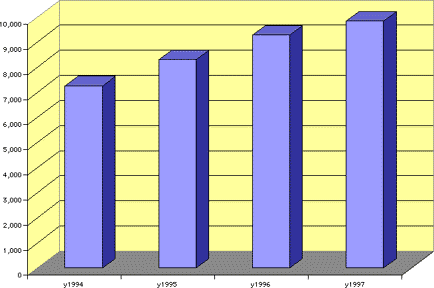|

SLOVENIA
GDP: U.S.$59.34 billion (2008);
Real GDP growth rate (2008 est.): 3.5%.
GDP per capita income (2008): U.S.$29,600,
Budget: Income .............. $22.55 Billion
Expenditure ... $22.77Billion
Main Crops: Potatoes, hops, wheat, sugar beets, corn, grapes; cattle, sheep, poultry .
Natural Resources: Lignite coal, lead, zinc, mercury, uranium, silver .
Major Industries: Ferrous metallurgy and rolling mill products, aluminum reduction and rolled products, lead and zinc smelting, electronics (including military electronics), trucks, electric power equipment, wood products, textiles, chemicals, machine tools .
|
| NATIONAL GNP |
 |
Slovenia enjoys prosperity and stability that are too often the exception in central and eastern Europe. Slovenia's economic success clearly illustrates the benefits of embracing liberal trade, following the rule of law, and rewarding enterprise. This success, however, is not unprecedented for Slovenia. Although it comprised only about one-thirteenth of Yugoslavia's total population, it was the most productive of the Yugoslav republics, accounting for one-fifth of its GDP and one-third of its exports. The country already enjoyed a relatively prosperous economy and strong market ties to the West when it gained independence in 1991. Since independence, Slovenia has pursued diversification of its trade toward the West and integration into Western and transatlantic institutions vigorously. In so doing, it has made substantial progress in its transition to a market economy, particularly becoming party to a number of bilateral and regional free trade agreements. Slovenia is a founding member of the WTO andÊjoined the Central European Free Trade Agreement (CEFTA) in 1996. Slovenia also participates in SECI, as well as in the Central European Initiative, the Royaumont Process, and the Black Sea Economic Council. Slovenia became a new EU member state on May 1, 2004.
Today, Slovenia is one the best economic performers in central and eastern Europe, with a GDP per capita estimated at U.S.$13,534--73% of the EU-15 average. Slovenia benefits from a well-educated and productive work force as well as dynamic and effective political and economic institutions. Although Slovenia has taken a cautious, deliberate approach to economic management and reform, with heavy emphasis on achieving consensus before proceeding, its overall record is one of success.
Slovenia has enjoyed healthy growth figures for the past 8 years, averaging 4.0% annual GDP growth. The European economic slowdown reduced the pace of growth somewhat beginning in 2001. GDP growth for 2003 is estimated at 2.7%, and 3.6% growth is forecast for 2004. Slovenia's economy is highly dependent on foreign trade. Trade equals about 120% of GDP (exports and imports combined). About two-thirds of Slovenia's trade is with the EU, a figure which will likely rise following its 2004 accession. Additionally, the country has penetrated successfully the south and east European markets, including the former Soviet Union region. This high level of openness makes Slovenia extremely sensitive to economic conditions in its main trading partners and changes in its international price competitiveness. Keeping labor costs in line with productivity is thus a key challenge for Slovenia's economic well-being. Services, notably in the financial sector, contribute the most to the national output, accounting for more than 60% of GDP. Industry and construction comprise over one-third of GDP; and, agriculture, forestry, and fishing account for nearly 3% of GDP.
Economic management in Slovenia is relatively good. Public finances have shown modest deficits on the order of 3.0% of GDP in 2002 and 1.5% in 2003. The budgets for 2004 and 2005 constrain public deficit to 1.7% of GDP, well within Maastricht parameters. The public debt to GDP ratio is 27.8% of GDP (2002). The current account balance has improved significantly as a result of stronger exports and a changed composition of imports by economic purpose. In 2003, the current account balance showed a surplus for the second year in a row. Based on 11-month data the surplus is estimated at U.S.$110 million. Controlling inflation remains a top government priority. While the authorities have been successful in stabilizing the Slovenian Tolar and in bringing inflation down from more than 200% in 1992 to 7.5% in 2002, the end of 2003 rate of 4.6% supports government plan for meeting Maastricht criteria in two years.
Due to its macroeconomic stability, favorable foreign debt position, and successful accession to the EU, Slovenia consistently receives the highest credit rating of all transition economies--receiving the top regional honors in a recent Dunn & Bradstreet survey. Slovenia's ability to meet its growth rate objectives will largely depend on the state of the world economy, since exports demand in Slovenia's primary market has stalled. Foreign direct investment (FDI) will take up the slack to some extent, as analysts forecast FDI levels will continue to increase with further privatization of state assets, including portions of the telecommunications, financial, and energy sectors. Slovenia must carefully address fiscal, monetary, and FDI policy, in light of the high deficit in pension accounts, its vulnerable Western export markets, and inflation concerns. Slovenian enterprises have a tradition of market orientation that has served them well in the transition period, as they moved energetically to reorient trade from former Yugoslav markets to those of central and eastern Europe. However, in many cases under the Slovenian brand of privatization, managers and workers in formerly "socially owned" enterprises have become the majority shareholders, perpetuating the practices of "worker management" that were the hallmark of the Yugoslav brand of communism. Difficulties associated with that model are expected to decrease under competitive pressures, as shares in these firms change hands, and as EU reforms introduce more Western-oriented governance practices.
Slovenia's entry into the European Union provides the impetus for further economic improvements. Economic policy is geared largely toward EU integration. The government continues to focus on adopting EU rules on the internal market, structural economic reform, reform of the judiciary and public administration, and introduction of E-administration. Harmonization with EU laws and regulations will remain a major challenge to the government in the near future. Slovenia's position with respect to other central and eastern European (CEE) countries will decline without further vigorous reforms.
Slovenia has taken some important steps in recent years to free up its financial markets. This sector historically has been one of the most protected, reflecting Slovenian concerns over limited capacity to face global competition and a desire to maintain domestic control over finance. A combination of market forces, changes in Bank of Slovenia regulations, and national legislation are moving this sector increasingly in a more globally oriented direction. In 2003, several measures were introduced to make both portfolio and direct investments easier and more transparent in Slovenia and to conduct many financial operations, including banking, securities brokering, and undertaking various credit transactions. MostÊremaining barriers were removed by May 1, 2004. For instance, marketing of foreign mutual investment funds is allowed as of May 1, 2004. The banking sector also is showing signs of stirring from its relative inactivity, as pressures build to consolidate Slovenia's myriad banks build and as privatization of two of the largest banks proceeds. While Belgian KBC became the Nova Ljubljanska Banka's (NLB) main owner with 34%, privatization of NKBM bank was postponed again. Insurance reform is still pending.
Government efforts and reforms designed to attract foreign direct investment (FDI) have proven successful--FDI almost tripled from 2001 to 2002, accounting for nearly 6.5% of GDP. However, FDI fell sharply in 2003 due to a lack of any major privatization deal or foreign acquisition. Slovenia's traditional anti-inflation policy in the past relied heavily on capital inflow restrictions. Its slow privatization process favored domestic investors and prescribed long lag time on share trading, complicated by a cultural wariness of being "bought up" by foreigners. As such, Slovenia has had a number of impediments to full foreign participation in its economy. However, a number of these barriers to FDI were fully removed in 2002. As a result, expected foreign takeovers of Slovenian blue chip companies, as well as EU membership, have fueled investors' interest in the country. Recent acquisitions by multinational companies--KBC of Belgium's takeover of Nova Ljubljanska Banka, and Swiss Novartis' takeover of Lek Pharmaceuticals--clearly demonstrate the attractiveness of the Slovenian economy, particularly to European investors seeking a platform to support expansion into southeastern Europe. U.S. investments in Slovenia have been more modest, Goodyear and Western Wireless International being the two largest American investors. Removal of administrative barriers, further liberalization of the financial sector, completion of privatization, and progress on company restructuring are necessary to improve economic performance at the macro and micro levels. Without these measures, employment and FDI figures may not reach their full capacity. |
|
|


